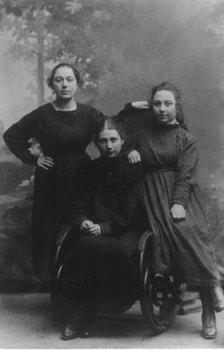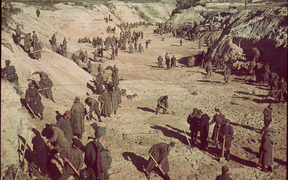 I was invited to give a presentation at a Christian-Jewish church service with a theme of persecution and immigration, as part of this year’s North Cornwall Book Festival. The recent horror of refugees trying to flee Afghanistan in the wake of the Taliban victory, and the plight of migrants making perilous sea crossings in an attempt to reach Europe or the UK, have once again brought these issues to the fore. My own family lived through the pogroms, a series of anti-Semitic riots that took place in the Russian Empire, which in many ways served as a precursor to the Holocaust. Today, we would probably call the pogroms a form of ‘state-sponsored terrorism’ against Jews – supported and incited by the government, if not actually perpetrated by it. They began in 1881, when Jews took the blame for the assassination of Tsar Alexander II, and continued in waves for the next 40 years, peaking in 1905 before coming to a head during the Russian Civil War – a chaotic and intensely violent period that lasted for about four years following the Bolshevik Revolution of 1917. During the civil war, the area where my family lived – near Kiev, in present day Ukraine – became a battleground with numerous armies criss-crossing the land – Communists, Nationalists, Anarchists, anti-Bolsheviks, peasant militias – all of them anti-Semitic to a greater or lesser degree. The White Army in particular, which was loyal to the Tsar – and backed by the West – introduced methods of mass murder of Jews that were later taken and pushed to their limit by the Nazis twenty or so years later. Many White Army soldiers later went on to join the Ukrainian militias that collaborated with the Nazis to destroy all Jewish life in Ukraine in the early 1940s. As well as the violence during the civil war, there was hunger. Food had become scarce during World War l, inflation soared making what little there was unaffordable, and the Bolsheviks requisitioned grain from the countryside (including from my great-great grandfather, who was a grain trader), to feed the workers in the towns. Not only did they take the grain, but also the seed, leaving the peasants with nothing to grow crops with the following year. The population was left to starve. My grandmother Pearl was around 17 years old at the start of the civil war, and an orphan. She lived with her grandparents, siblings and cousins and took it upon herself to become the family breadwinner, undertaking terrifying and dangerous journeys by train to markets across the region to buy, sell and barter what she could to keep her family alive. Eventually she even became a black-market gold dealer – taking any gold items belonging members of her local community on a murderous journey half way across Ukraine to exchange them for hard currency, which she brought back to the villagers so they could use it to buy food. Had she been caught, either with the gold or hard currency, she would have been shot. After more than three years of this perilous life that she hated with a passion, and following a particularly arduous trading trip when she was caught in a snowstorm and almost froze to death, she could take it no more. She decided she must try to get herself and her family out of the country. Six months later, in 1924, Pearl managed to emigrate to Winnipeg, Canada to join some other members of her extended family who had already made it out of Russia. She travelled alone, and with nothing. Once in Canada she did what so many immigrants do. She found a job and worked hard, scrimping, saving, and borrowing to raise enough money to bring the rest of her family over to join her the following year. Today my family is spread across Canada, from Vancouver to Toronto, and in America from California to New York, as well as in Germany, Israel and the UK, where they became, among other things, teachers and lawyers, journalists and doctors, Rabbis and social workers, all adding in their own unique ways to the prosperity and cultural life, as well as the wonderful diversity, of the places they now call home. Photo: Pearl (left) with her sisters Sarah (centre) and Rachel, circa 1920
0 Comments
 This month marks the 80th anniversary of the worst of the Nazis’ multitude of atrocities on Ukrainian soil, the massacre at Babi Yar on 29-30 September 1941, which began on the eve of Yom Kippur. The Babi Yar tragedy was largest open-air massacre during the so-called Holocaust by Bullets, when 33,771 people – according to meticulous record-keeping by the SS – mostly women, children and the elderly, were shot. In the months that followed, tens of thousands more people were murdered at Babi Yar, the overwhelming majority Jews, but also Roma, Ukrainian nationalists and Soviet prisoners of war. The killing came to a halt in 1943, with the Germans in retreat from the Soviet territory they had occupied. Berlin ordered that mass execution sites be excavated so the corpses could be burned, fearing that the Soviet Union would use them as evidence for propaganda purposes. Until its collapse in the 1990s, the Soviet Union suppressed memory of the Jewish genocide that had taken place on its soil. National policy was to erase differences among the victims of Nazism. This included ‘erasing’ the ravine itself by filling it with industrial waste and making way for what exists at the site today – a wide street lined on one side with apartment blocks, and a grassy park on the other, where children play and lovers meet. “Babi Yar is a symbol of the Soviet Union’s efforts to physically erase memory. They took the most tragic part of our history and tried to make it disappear. Thanks to an independent Ukraine, the policy was fully changed towards the memory of the Holocaust,” human rights activist and chairman of the Babi Yar Holocaust Memorial Center, Natan Sharansky, said last year at a ceremony to mark the anniversary of the massacre. The Memorial Center, established in 2016 to build a major new Holocaust museum in Kiev, is due to open its doors in 2026 but has already been the subject of considerable controversy. The disagreements stem largely from the appointment of the contentious Russian filmmaker Ilya Khrzhanovsky as artistic director and his plans for a virtual reality installation, deemed inappropriate by many and dubbed a “Holocaust Disneyland” by one former curator when he quit the project. Objections have also been raised about the role of some of the Center’s Russian Jewish billionaire funders and its location in the grounds of an old Jewish cemetery. But a number of research projects developed by the Center have yielded fascinating results. Last year a 3D model of the massacre site was created, led by former Scotland Yard investigator Martin Dean, who specialises in Nazi war crimes. By combining ground and aerial photography, maps, historical reports and witness testimonies, Dean was able to build an overall picture of a mass grave about 150 metres long, in which corpses were stacked in layers like sardines, and to pinpoint for the first time in three-quarters of a century exactly where it was located. Another recent research initiative is the Names Project, which has uncovered the identities of more than 900 of the victims of Babi Yar, whose fates had previously been unknown. Estimates of the total death toll at Babi Yar in 1941-43 range from 70,000 to 100,000. Apart from details of the September massacre, records of those killed were sporadic. The Names Project is attempting to collect data on all those murdered at Babi Yar and the researchers hope eventually to have a web page for each identified victim, complete with details of their life story and a picture. In partnership with the Memorial Center, Ukrainian director Sergei Loznitsa released a film this year to coincide with the 80th anniversary. Babi Yar.Context – a series of short documentaries – premiered at the Cannes Film Festival in July. Loznitsa was born close to Babi Yar but grew up in ignorance of what had happened there. His film is based on archival material using footage from the period, including newsreels, court trials and amateur films by German soldiers. It begins with Germany’s invasion of Ukraine in 1941 and concludes in March 1961 with the little-known Kurenivka mudslide – a disaster that resulted from the Soviet authorities’ attempts to erase memory of Babi Yar by filling the ravine with industrial waste. A decade later, heavy rain caused a dam securing a brick pulp dump to collapse, triggering a mudslide that released up to four metres of mud, water and human remains onto the streets. A recent report estimates that 1,500 people may have died as a result. |
Keeping stories aliveThis blog aims to discuss historical events relating to the Jewish communities of Ukraine, and of Eastern Europe more widely. As a storyteller, I hope to keep alive stories of the past and remember those who told or experienced them. Like so many others, I am deeply troubled by the war in Ukraine and for the foreseeable future, most articles published here will focus on the war, with an emphasis on parallels with other tumultuous periods in Ukraine's tragic history. Archives
March 2024
Categories
All
|
 RSS Feed
RSS Feed
